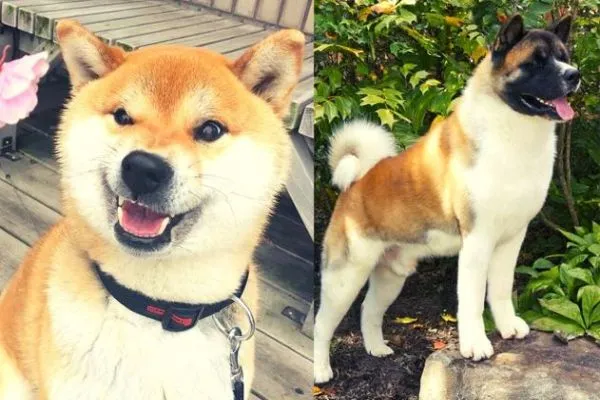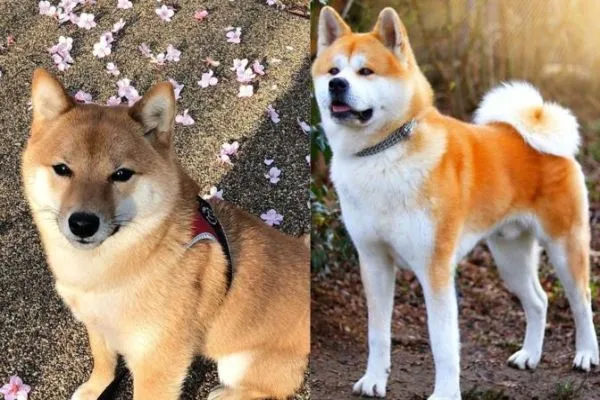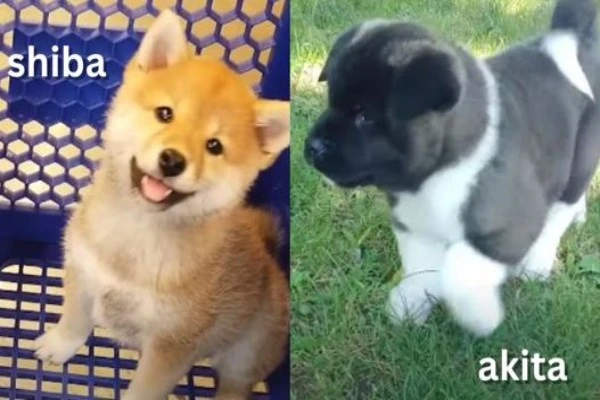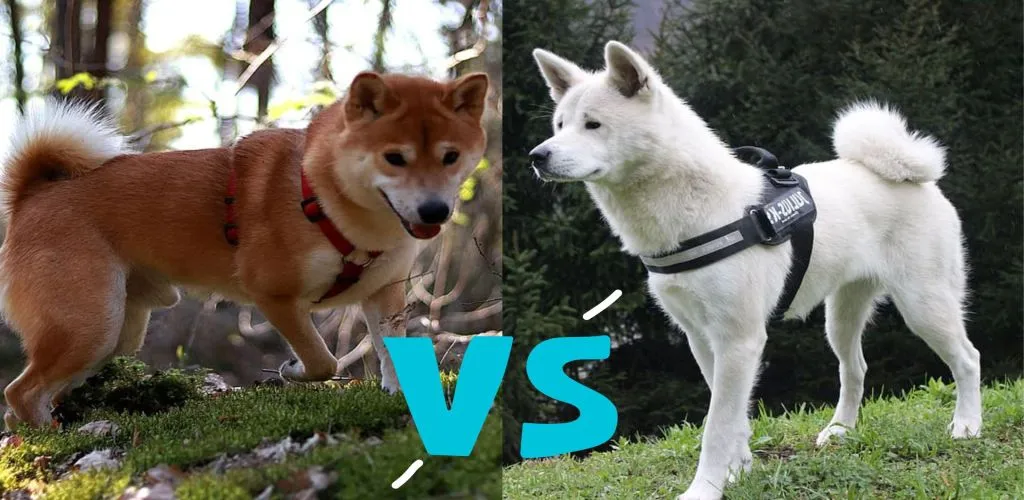Contents
- 1 Shiba Inu vs Akita: History and Origin
- 2 Shiba Inu vs Akita: Physical Appearance
- 3 Shiba Inu vs Akita: Temperament and Behaviour
- 4 Shiba Inu vs Akita: Lifespan and Size
- 5 Shiba Inu vs Akita: Trainability
- 6 Shiba Inu vs Akita: Adaptability
- 7 Shiba Inu vs Akita: Dietary Nutrition
- 8 Shiba Inu vs Akita: Health issues
- 9 Shiba Inu vs Akita: Price
- 10 FAQ
- 11 Final Thoughts
You may be wondering, what are the differences between the Shiba Inu and Akita breeds?
In this article, we’ll dive deep into the world of Shiba Inu vs Akita, exploring the differences between their history, physical appearance, temperament, and more.
Get ready to unravel the mysteries of these enchanting breeds and discover which one is the perfect match for you.
Let the battle begin!
Shiba Inu vs Akita: History and Origin
Shiba Inu and Akita are two distinct breeds of dogs that originated in Japan. While they share some similarities in terms of appearance, they have different histories and origins.
The Shiba Inu’s ancestors can be traced back to ancient Japan, dating back more than 2,000 years. It is believed that these dogs were bred to hunt small game, such as birds and rabbits, in the mountainous regions of Japan.
Over time, several regional variations of the Shiba Inu developed across Japan. These variations were named after the regions they originated from, such as the Shinshu Shiba, Mino Shiba, and San’in Shiba.
Eventually, these regional variations were standardized, resulting in the Shiba Inu breed we know today.
On the other hand, The Akita’s history can be traced back to ancient Japan, where they were initially used as hunting dogs for big game, such as bears, boars, and deer.
They were also employed as guard dogs and even as symbols of the samurai warrior class.
Akitas were highly revered in Japanese culture and were often kept by nobles and members of the imperial family. They were considered symbols of good luck, protection, and prosperity.
In summary, both the Shiba Inu and Akita have ancient origins in Japan, but their histories and origins differ.
Also, Read- Shar pei Dog price in India
Shiba Inu vs Akita: Physical Appearance
Unmistakably, the Akita’s majestic stature and the Shiba Inu’s compact size paint contrasting pictures of canine gracefulness. When comparing their physical appearances, there are several notable differences between the Shiba Inu and Akita.
Starting with their coat colour, Shibas come in various shades such as red, sesame, black, and tan, while Akitas commonly have a more limited range of colours like white, brindle, and pinto.
Moving on to facial features, Shibas have a fox-like face with small, almond-shaped eyes, while Akitas possess a powerful, broad face with larger eyes.
In terms of body structure, Shibas are lean and muscular, while Akitas are more robust and substantial. Additionally, Shibas have a curled tail, reminiscent of a sickle, while Akitas have a thick, curled tail that rests on their back.
Lastly, Shibas have small, triangular ears, while Akitas have larger, erect ears.
These physical differences contribute to the unique charm and distinctiveness of each breed.
Shiba Inu vs Akita: Temperament and Behaviour

When it comes to socialization challenges, Shiba Inus tend to be more reserved and aloof with strangers, while Akitas are known for their protective nature and can be cautious around new people.
In terms of exercise requirements, Shiba Inus are known for their high energy levels and need plenty of physical and mental stimulation. At the same time, Akitas are more laid-back and require moderate exercise.
Barking tendencies also vary, with Shiba Inus being more vocal and prone to barking, while Akitas are generally quieter.
Lastly, both breeds can be good with children, but proper supervision and socialization are crucial to ensure a positive interaction
Also, Read- Chow Chow Price in India
Shiba Inu vs Akita: Lifespan and Size
When it comes to lifespan comparison, the Shiba Inu typically lives between 12 to 15 years, while the Akita has a slightly shorter lifespan of 10 to 13 years.
It’s important to note that individual dogs may vary and proper care can help extend their lifespan.
Moving on to size comparison, the Shiba Inu is considered a small to medium-sized breed.
They usually stand about 13.5 to 16.5 inches tall at the shoulder and weigh around 17 to 23 pounds.
On the other hand, the Akita is a large breed, standing around 24 to 28 inches tall and weighing between 70 to 130 pounds. Their size difference is quite significant.
It’s important to note that both breeds have different growth rates, with the Shiba Inu reaching its full size by around one year old, while the Akita continues to grow until it’s around two years old.
Shiba Inu vs Akita: Trainability

When it comes to training, both the Shiba Inu and the Akita have their own unique characteristics and challenges.
The Shiba Inu is known for its independent and stubborn nature, which can make training a bit more challenging. They’re intelligent dogs, but they have a strong sense of self and may not always be motivated to obey commands.
On the other hand, the Akita is known for its loyalty and willingness to please, which can make training a bit easier. They’re intelligent dogs as well, and with proper socialization and behaviour modification, they can become obedient and well-behaved pets.
Both breeds require consistent training and positive reinforcement methods to ensure success. It’s important to start training early and to be patient and persistent with both breeds.
Also, Read- 21 Best Dog Breeds For Indian Climate
Shiba Inu vs Akita: Adaptability
When it comes to adaptability, both the Shiba Inu and the Akita have their unique qualities.
Starting with exercise needs, the Shiba Inu requires moderate exercise, while the Akita has a higher need for physical activity.
If you have a small living space like an apartment, the Shiba Inu is a better choice as they are more adaptable to confined spaces.
On the other hand, the Akita is better suited for a larger living space like a house with a yard where they can roam freely.
In terms of weather tolerance, the Shiba Inu fares better in warmer climates, while the Akita thrives in colder environments due to their thick double coat
Shiba Inu vs Akita: Dietary Nutrition

One key aspect to consider when comparing the Shiba Inu and Akita breeds is their dietary nutrition. Canine nutrition plays a crucial role in the overall health and well-being of these dogs. Both breeds have specific dietary requirements and feeding habits that need to be taken into account.
Shiba Inus and Akitas have different nutritional needs due to their size and activity levels. While Shibas are smaller and more active, Akitas are larger and require a diet that supports their growth and muscle development.
When it comes to food preferences, Shibas tend to be picky eaters and may require a variety of flavors to keep them interested in their meals. Akitas, on the other hand, have a hearty appetite and may need portion control to prevent overeating.
Understanding their unique dietary needs is essential in providing them with the proper nutrition for a healthy and balanced diet.
Also, Read- Vizsla Dog Price in India
Shiba Inu vs Akita: Health issues
It’s important to be aware of the common health problems that these breeds may face. Shiba Inus are generally a healthy breed, but they can be prone to allergies and certain genetic predispositions, such as hip dysplasia and patellar luxation.
On the other hand, Akitas are known to have a higher risk of developing autoimmune disorders, hypothyroidism, and progressive retinal atrophy.
Both breeds require regular exercise to maintain their overall health and prevent obesity. Shiba Inus are more energetic and need daily walks or playtime, while Akitas have a moderate exercise requirement.
Regular veterinary care, including vaccinations and check-ups, is crucial for the well-being of both Shiba Inus and Akitas.
Shiba Inu vs Akita: Price

When it comes to the Shiba Inu and Akita, there are several factors that can influence their price range.
Both breeds are highly sought after, but the Akita tends to be more expensive due to its larger size and higher demand.
On average, you can expect to pay between 50,000 to 1,00,000 INR for a Shiba Inu, while an Akita can cost anywhere from 1,00,000 to 2,00,000 INR.
Breeder availability also plays a role in the price variation. Additionally, the popularity of certain colours can affect the price. For example, Shiba Inus in the red and sesame colours are often in higher demand and may be priced higher.
When considering the price of these breeds, it’s important to also think about the maintenance cost. Both the Shiba Inu and Akita require regular grooming, vaccinations, and quality food, which can add up over time.
Also, Read- Popular Japanese Dog Breeds in the World
FAQ
Are Shiba Inus and Akitas suitable for apartment living?
Both Shiba Inus and Akitas can adapt to apartment living, but Shiba Inus are generally more adaptable due to their smaller size and lower exercise requirements compared to Akitas.
Which breed requires more exercise, a Shiba Inu or an Akita?
Akita requires more exercise compared to Shiba Inua, Akita are large and very energetic breed, due to which they they need more exercise daily to keep them healthy and stimulated. Shiba Inu still need daily exercise but their exercise demand is less due to their small size and medium energy levels.
Can Shiba Inus and Akitas coexist peacefully with other pets?
Introducing Shiba Inus and Akitas to other pets can be challenging, but with proper training techniques and socialization, they can peacefully coexist. Common challenges include territorial behaviour, but success stories show that it’s possible for them to get along.
Do Shiba Inus and Akitas shed a lot?
Shiba Inus and Akitas both shed quite a bit. They have a moderate shedding intensity and require regular grooming to manage their fur. While not hypoallergenic breeds, shedding control products can help reduce the amount of hair in your home.
Are Shiba Inus and Akitas prone to separation anxiety?
Shiba Inus and Akitas can both be prone to separation anxiety. They are loyal breeds and strongly bond with their owner so it is not recommended to leave them alone for longer periods of time.
Final Thoughts
These two breeds may have some similarities, but they are also quite different.
While the Shiba Inu is like a fiery spark, full of energy and independence, the Akita is like a majestic mountain, exuding strength and loyalty.
So, whether you prefer a lively companion or a regal protector, make your choice wisely and enjoy the journey with your furry friend.
Hope you found it helpful
Thank you for Reading.
